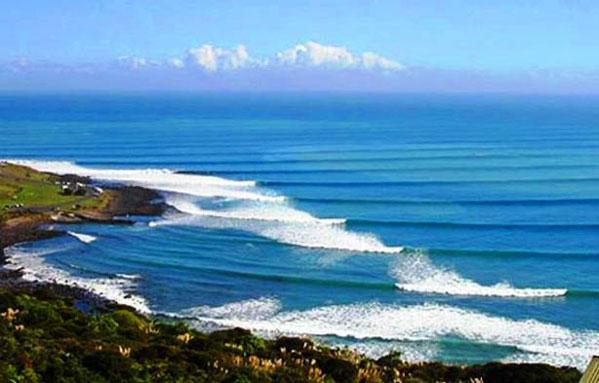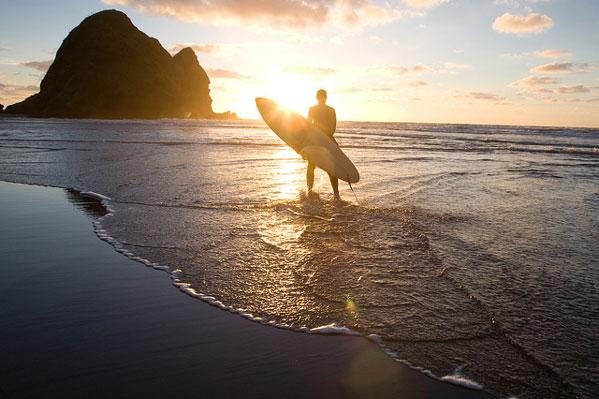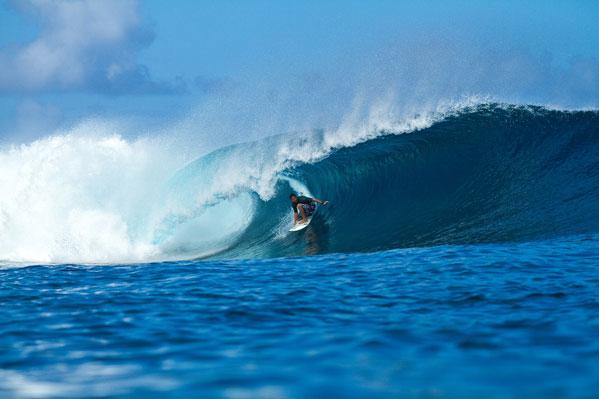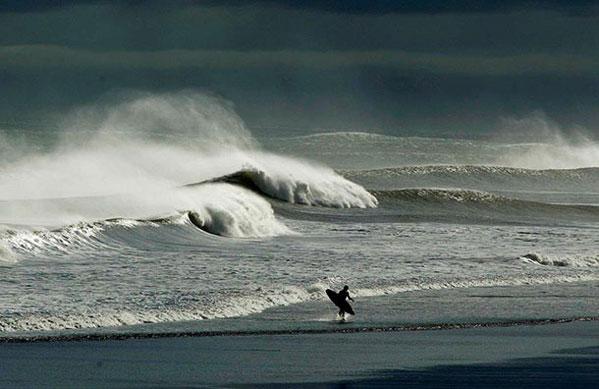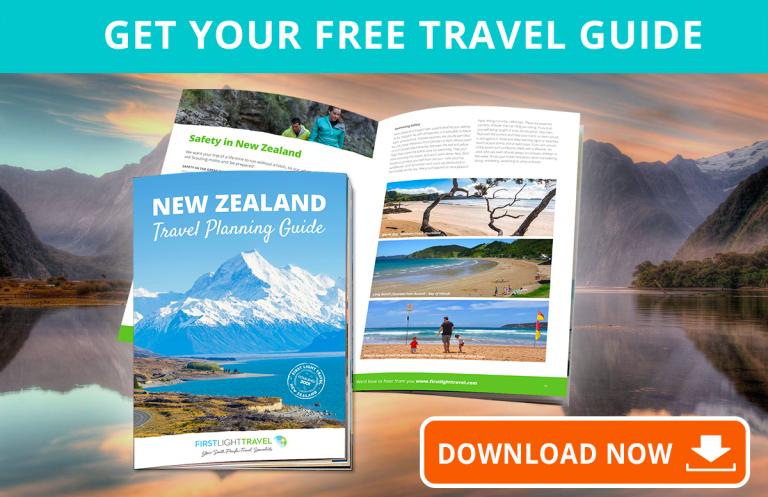
It is no wonder that we are passionate about surfing, our 6,000 kms of exposed coastline offers some of the most consistent and crowd free surfing in the southern hemisphere. The variety of surf breaks is simply awesome - from clean barrels rolling onto pure white sand beaches on the east coast, to gnarly freight train sets pounding rugged west coast beaches.
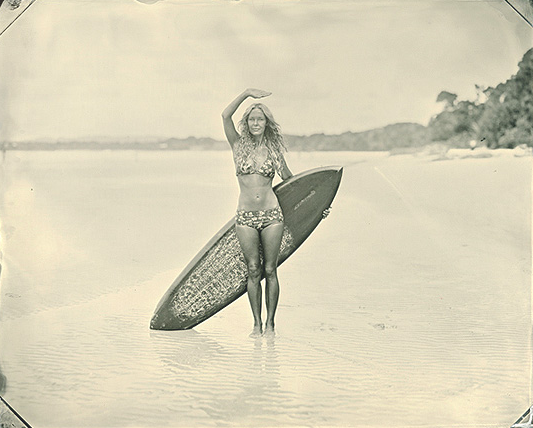
Contents
Surfing New Zealand
Check out our ‘supertubes’ with one kilometre long joy rides at Ahipara and the consistently perfect peelers at our hottest surf spot, Raglan. Experience giant steamrollers and Malibu-style wave sets at Murderer’s Bay in Dunedin, as well as velvet-smooth tunnels at Gisborne. Our beaches can be surfed all year round.
The North Island has very warm temperatures in summer (December-March) and wet suits are not usually needed. The South Island waters are colder and generally call for some neoprene protection. The long insular shape of the country means that you can quickly move across from one coast to the other. So wherever you are in the country there’s bound to be a good break nearby. A glance at the local weather map will tell you which coast has the right swell. What makes the culture of surfing distinct in New Zealand, is its growth through surf-lifesaving.
In other countries, surfing developed early on as a kind of loafer counter-culture. Here, it is a sport for anyone and features no one specific stereotype, you could be in the water with a doctor or lawyer one minute and a plumber painter the next. It is so popular with young New Zealanders, that it is even available as a sport option in some high schools. We see it as an opportunity to challenge nature and the elements, and to conquer something that can only be conquered for a moment in the great out doors. Surfing New Zealand’s fastest growing recreational sports.
Some of the Top New Zealand Surfing Spots
Raglan Beach
Famous for surfing, music, artisans, cafés and bohemian lifestyle’s, the Raglan community is only 35 minute drive from Hamilton and just two hours from Auckland on the beautiful west coast of the North Island. This is a relaxing isolated place where you can spend time at one of the many black sand beaches swimming, surfing, and body boarding or just working on the perfect tan! The area is world renowned for it's surfing and has some of the best waves in New Zealand, especially just out of Raglan at Whale Bay and Manu Bay where clean glassy left handers roll into the beach. Nearby are the Bridal Veil Falls which are an impressive sight falling around 60 meters (196 feet) – well worth a look.
Piha
Piha, Auckland's favourite west coast beach is probably New Zealand's second best-known surfing beach after Raglan, and it has a reputation for awesome surf. It was the birthplace of New Zealand board riding in 1956 and has been the scene of both New Zealand national and international surfing championship competitions. This black ironsand beach is notorious for its rips and currents, so is not a good beach for novices to attempt. Two Surf Lifesaving Clubs provide surf patrols in summer.
Gisborne Surfers Paradise
Fancy a visit to a genuine, laid-back Kiwi surf town, which boasts some of the best summer weather, warm water and a bucketful of different surf breaks to suit board riders? Gisborne’s marvellous surf beaches have attracted surfers since the early 1960’s. The coastline is affected by long ocean swells coming from both the east and south so you can usually catch a wave at one of the local beaches. Dawn surfing is a buzz because Gisborne is the first place in the world to see the sunrise each day. Makorori Point (8 kms or 5 Miles from Gisborne) is a famous surf location, which has all the qualities of a perfect surfing hangout. A right-hander breaks over a shallow reef system setting up a long sweeping ride that is a surfer’s dream. Watch for a south or south-east swell and waves around 2 metres from mid to high tide for the epic wave that will replay over and over in your mind.
Big-Wave Surfing in the Deep South
In a place known as the Deep South, is a region stretching from Dunedin to the bottom end of the South Island. Geographically the area is wide open to big uninterrupted Southern Ocean swells ranging from 1 m-3m, but 4m to 6m-plus waves are a regular occurrence throughout the year and has all the makings of a big wave rider's dream. So if you are an experienced thrill seeker wanting to put everything on the line then hunt out the Deep South big-wave scene that has begun to emerge lately - a tight but significant core of eager and able surfers who are paddling and towing into ever more serious slabs of ocean. Centre (Rarotoka) Island and Papatowai are two formerly obscure spots which have regularly been ridden in the last few years, and new discoveries and previously untameable Shark Island-type waves have started to tempt those willing to brave the consequences and the cold. But in New Zealand, size comes at a price. The trade-off for being the only part of the country to receive genuine big waves is the biting cold and radical weather. Even on glassy, sunny days, the full rubber kit from head to toe is essential. Winter days are often plagued by squally gales of such force that they make going outside an unlikely option, even for the farmers.
Ready to plan your surfing experience in New Zealand?
Get in touch with our Travel Specialists who will be happy to assist you with arranging your dream trip
There’s all the wave-riding adventure you could possibly desire on our shores, complemented by stunning scenery, uncrowded waves, kiwi culture and friendliness - all absolutely free for your enjoyment.
Recent Posts
Blog Categories
Blog archives
- February 2025 (3)
- January 2025 (6)
- December 2024 (12)
- November 2024 (3)
- October 2024 (2)
- July 2024 (2)
- May 2024 (12)
- April 2024 (2)
- March 2024 (2)
- January 2024 (2)
- November 2023 (10)
- October 2023 (4)
- August 2023 (1)
- May 2023 (2)
- April 2023 (2)
- March 2023 (17)
- February 2023 (4)
- January 2023 (4)
- December 2022 (11)
- November 2022 (7)
- October 2022 (1)
- May 2022 (1)
- March 2022 (3)
- February 2022 (3)
- January 2022 (1)
- December 2021 (1)
- August 2021 (1)
- June 2021 (1)
- May 2021 (2)
- February 2021 (1)
- August 2020 (1)
- July 2020 (1)
- May 2020 (1)
- April 2020 (1)
- March 2020 (1)
- January 2020 (1)
- December 2019 (1)
- November 2019 (1)
- October 2019 (1)
- September 2019 (1)
- August 2019 (5)
- July 2019 (2)
- June 2019 (1)
- May 2019 (3)
- April 2019 (1)
- March 2019 (1)
- February 2019 (1)
- January 2019 (1)
- December 2018 (1)
- November 2018 (1)
- September 2018 (1)
- August 2018 (1)
- July 2018 (1)
- June 2018 (1)
- May 2018 (1)
- April 2018 (1)
- March 2018 (1)
- February 2018 (1)
- January 2018 (1)
- December 2017 (1)
- October 2017 (1)
- September 2017 (1)
- August 2017 (1)
- July 2017 (1)
- June 2017 (1)
- May 2017 (1)
- April 2017 (1)
- March 2017 (1)
- February 2017 (1)
- January 2017 (1)
- December 2016 (1)
- November 2016 (1)
- October 2016 (1)
- September 2016 (1)
- August 2016 (1)
- July 2016 (1)
- June 2016 (1)
- May 2016 (1)
- April 2016 (1)
- March 2016 (1)
- February 2016 (1)
- January 2016 (1)
- December 2015 (1)
- November 2015 (1)
- October 2015 (1)
- September 2015 (1)
- August 2015 (1)
- July 2015 (1)
- June 2015 (1)
- May 2015 (1)
- April 2015 (1)
- March 2015 (1)
- February 2015 (1)
- January 2015 (1)
- December 2014 (1)
- November 2014 (1)
- October 2014 (1)
- September 2014 (1)
- July 2014 (1)
- June 2014 (3)
- May 2014 (1)
- April 2014 (1)
- March 2014 (1)
- February 2014 (1)
- January 2014 (1)
- November 2013 (15)
- October 2013 (1)
- September 2013 (1)
- August 2013 (1)
- July 2013 (1)
- May 2013 (1)
- April 2013 (1)
- March 2013 (1)
- February 2013 (1)
- January 2013 (1)
- December 2012 (1)
- November 2012 (2)
- October 2012 (2)
- September 2012 (2)
- August 2012 (2)
- July 2012 (2)
- June 2012 (2)
- May 2012 (2)
- April 2012 (3)
- March 2012 (2)
- February 2012 (2)
- January 2012 (3)
- December 2011 (1)
- November 2011 (1)
- October 2011 (2)
- September 2011 (1)
- August 2011 (1)
- July 2011 (1)
- June 2011 (1)
- May 2011 (1)
- April 2011 (1)
- March 2011 (1)
- February 2011 (1)
- January 2011 (1)
- December 2010 (1)
- November 2010 (1)
- October 2010 (1)
- September 2010 (1)
- August 2010 (1)
- July 2010 (1)
- June 2010 (1)
- May 2010 (1)
- March 2010 (1)
- February 2010 (1)
- January 2010 (1)
- December 2009 (1)
- November 2009 (1)
- October 2009 (1)
- September 2009 (1)
- August 2009 (1)
- July 2009 (1)
- June 2009 (1)
- May 2009 (1)
- April 2009 (1)
- March 2009 (1)
- February 2009 (1)
- January 2009 (1)
- December 2008 (1)
- May 2005 (1)



